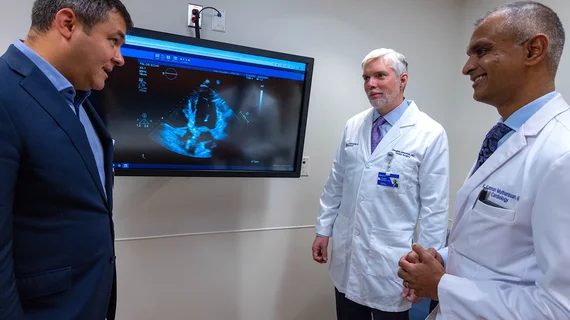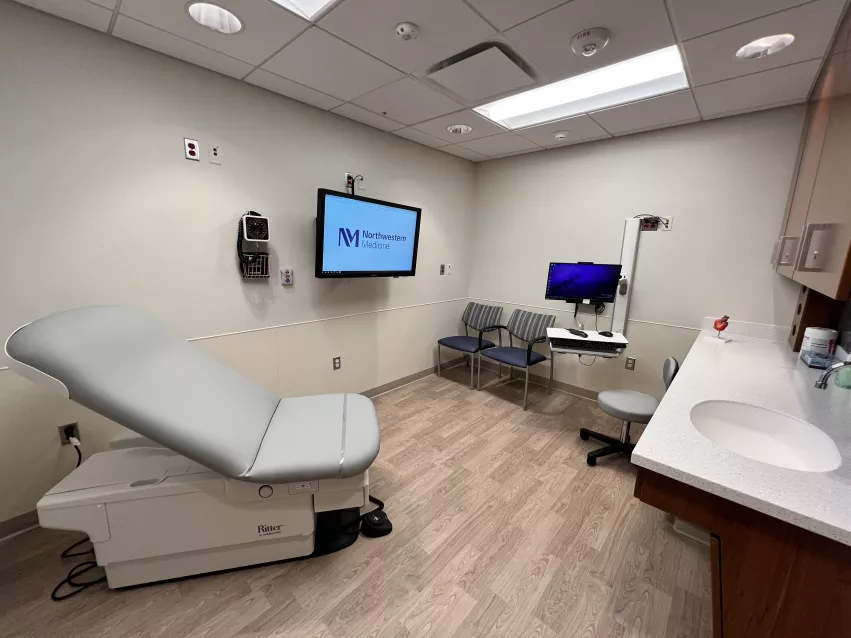Northwestern Medicine opens advanced outpatient cardiac clinic at suburban Chicago
The Northwestern Medicine Bluhm Cardiovascular Institute in downtown Chicago is noted as one of the premier cardiovascular centers in the country, but the hospital system found that notoriety did not translate into most patients in south suburban or South Side Chicago wanting to make the trip downtown. So today, Northwestern Medicine opened the Bluhm Cardiovascular Institute Outpatient Cardiology Clinic at the system's Palos Hospital, located in Palos Heights in the south suburbs.
The new clinic features 16 exam rooms, consult room and dedicated clinician workspaces. An expanded cardiac diagnostics area is scheduled to open at the site in early 2023, offering heart failure and echocardiography rooms for testing. It will provide dedicated clinical space for 12 physicians and six advanced practice nurses, including general cardiologists, interventional cardiologists, cardiac electrophysiologists, heart failure specialists and cardiac surgeons.
The new cardiac clinic was created to better serve patients, Northwestern said. Over the past decade, Northwestern created a nine-hospital system. For cardiology, it works as a hub-and-spoke model, where patients requiring more advanced care can be sent to the main Northwestern Hospital in downtown Chicago.
The health system has worked to bring some of the advanced procedures and device technologies, like transcatheter aortic valve replacement (TAVR) and advanced cardiac ablation procedures, to its surburban cardiac centers. However, patients in the south suburbs and and South Side still had limited access. Patients would have to travel 30-40 miles to the downtown Chicago location, which takes more than one hour both ways by car on most weekdays.
“The new outpatient clinic is the latest example of Northwestern Medicine’s commitment to provide outstanding clinical care close to where people live and work,” said R. Kannan Mutharasan, MD, medical director of Northwestern Medicine Bluhm Cardiovascular Institute at Palos Hospital in a statement. “The opportunity for our clinicians to work together in a modern environment enhances collaboration and is more convenient for patients who may need to see more than one specialist or require frequent testing.”
Since launching at Palos Hospital in October 2021, the Bluhm Cardiovascular Institute has introduced new cardiology services in the region. This includes the implantable CardioMEMS device to monitor heart failure patients, and the Shockwave technology to break up calcified coronary arteries without vessel trauma. The hospital recently introduced more advanced cardiac surgeries, such as total thoracoscopic maze to treat atrial fibrillation.
“Bluhm Cardiovascular Institute is dedicated to improving heart care by pioneering advanced treatments, performing groundbreaking clinical research, and incorporating innovative technology and artificial intelligence into clinical practice,” said Patrick M. McCarthy, MD, executive director of Bluhm Cardiovascular Institute and vice president of Clinical Integration for Northwestern Medical Group, in the same statement. “We are excited to expand this vision to the south suburbs with talented cardiologists and surgeons who are seeing patients at the new clinic at Palos Hospital.”
Creating the cardiac clinic of the future
Two of the exam rooms at the clinic are designed as “clinic of the future” models. These rooms are outfitted with large wall-mounted screens that face the clinician and patient for interactive visuals. Additional advancements planned in the coming months include ambient listening devices, with patient consent, that will test the ability to create clinician-facing documentation for the visit, generate orders and display patient-facing instructions. Northwestern said the concept might also test integration with patient wearables, such as a heart rate or blood pressure monitors.
“The ‘clinic of the future’ is about more than just the technology,” Mutharasan explained. “It’s about connecting the patient and the clinician to humanize healthcare."
The new technology is supposed to enhance the overall patient experience and create a more coordinated plan of care. This includes seamless check-in, automating some nursing tasks and improving the availability and accuracy of information.
Northwestern addressing health inequities with new clinics
Five of Northwestern's suburban hospitals are located in more affluent areas in the north and far west suburbs of Chicago, and two are located in rural areas west of the metro area. Palos Hospital is located in the south suburbs, where many areas are less affluent. The hospital is also the closest Northwestern hospital to some areas of the south side of Chicago.
Northwestern said it is working toward addressing inequities in the access to care in the south suburbs part with this new cardiac clinic.
Additionally, Northwestern said it plans to open a new outpatient facility on the city's south side Bronzeville neighorhood to provide better healthcare access to this predominately Black, and lower-income area of the city. Several south side hospitals have closed over the past two decades. The new facility plans to open in 2025 to help bring back access to care for residents there.
"This is not theoretical, or if we have enough revenue left over, this is baked into our fiscal plan," explained Clyde Yancy, MD, MSc, vice dean for diversity and inclusion, chief of cardiology in the Department of Medicine, and a professor of medicine in cardiology and medical social sciences, at Northwester Medicine. He spoke to Cardiovascular Business at the American Heart Association (AHA) 2022 meeting in November. "This is a commitment that we will be on the ground and doing business there in 2025. This really is a response to what the community needs. We understand that for us to be viable in a multiracial, multi-ethnic, incredibly large, pace-setting city in this country, we have to be present in all communities and provide services to all patients."
He said it is not just about providing healthcare, but health equity in the region Northwestern serves, and address in the needs of its patient population, regardless of their zip code.


